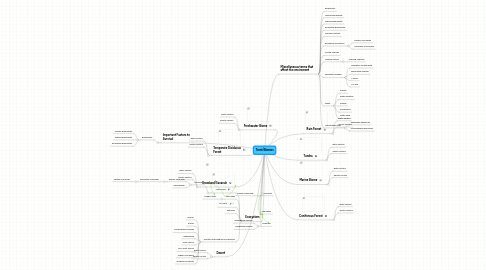Trent/Biomes
por Trent Hale


1. Organism
1.1. Endangered Species
1.2. Threatened Species
2. Population
3. Comunity
3.1. Climax Community
4. Temperate Diciduous Forest
4.1. Biotic Factors
4.2. Abiotic Factors
5. Desert
5.1. Biotic Factors
5.2. Abiotic Factors
6. Freshwater Biome
6.1. Biotic Factors
6.2. Abiotic Factors
7. Grassland/Savanah
7.1. Biotic Factors
7.2. Abiotic Factors
8. Ecosystem
8.1. Food Chain
8.1.1. Producer
8.1.1.1. Primary Consumer
8.1.1.1.1. Secondary Consumer
8.1.1.2. Decomposer
8.2. Food Web
8.2.1. Trophic levels
8.3. Hot Spot
8.4. Wetlands
8.5. Pollution Affecting Our Ecosystems
8.5.1. Erosion
8.5.2. Runoff
8.5.3. Impermeable Surfaces
8.5.4. Urbanization
8.5.5. Point Source
8.5.6. Non-Point Source
8.5.7. Organic Pollutants
8.5.8. Inorganic Pollutants
9. Important Factors to Survival
9.1. Biodiversity
9.1.1. Genetic Biodiversity
9.1.2. Species Biodiversity
9.1.3. Ecosystem Biodiversity
10. Rain Forest
10.1. Biotic Factors
10.2. Abiotic Factors
11. Coniforous Forest
11.1. Biotic Factors
11.2. Abiotic Factors
12. Tundra
12.1. Biotic Factors
12.2. Abiotic Factors
13. Marine Biome
13.1. Biotic Factors
13.2. Abiotic Factors
14. Miscellaneous terms that affect the enviroment
14.1. Biodiversity
14.2. Genetic Biodiversity
14.3. Species Biodiversity
14.4. Ecosystem Biodiversity
14.5. Indicator Species
14.6. Ecological Succession
14.6.1. Primary Succession
14.6.2. Secondary Succession
14.7. Pioneer Species
14.8. Limiting Factors
14.8.1. Carrying Capacity
14.9. Population Growth
14.9.1. Population Growth Rate
14.9.2. Exponential Growth
14.9.3. J Curve
14.9.4. S Curve
14.10. Water
14.10.1. Aquifer
14.10.2. Water Pollution
14.10.3. Aquifer
14.10.4. Desalination
14.10.5. Water shed
14.11. Natural Resources
14.11.1. Renewable Resources
14.11.2. Nonrenewable Resources
